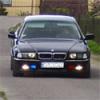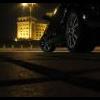


In celebration of the 30th anniversary of the debut of the quattro, Audi is presenting a show car at the 2010 Paris Motor Show that moves a futuristic interpretation of this concept into the fast lane: the Audi quattro Concept, a thoroughbred driving machine with 300 kW (408 hp), five-cylinder turbocharged engine, a lightweight body and - of course - the latest generation of quattro permanent all-wheel drive.
The 1980 Geneva Motor Show saw the debut of an automobile, whose name went on to become more than just a symbol for a long line of success by the manufacturer. The quattro from Audi is also the gold standard for the combination of winning motor sport qualities with the utmost in everyday practicality.
The very first glimpse of the new Col de Turini White show car awakens memories of another legendary ancestor: the 1984 Sport quattro, a 306 hp evolutionary stage of the Audi quattro Coupé with a shortened wheelbase. In fact, the Audi quattro Concept also represents the systematic further development of a production coupé using high-performance technology. The foundation is provided by the powerful Audi RS5, one of the brand's sportiest production vehicles ever.
The low weight of the superstructure leads to significant secondary effects in other components of the vehicle, such as the transmission, the chassis and the brake system. As a result, the Audi quattro Concept weighs just 1,300 kilograms (2,866.01 lb), almost exactly the same as the Sport quattro from 1984. This once again moves Audi, the pioneer of lightweight construction, to the head of the pack.
The know-how and technologies of the Audi quattro Concept body will characterize Audi's entire production model portfolio in the future.
In another move that benefits the vehicle's weight, the eight-cylinder engine from the production model has been replaced under the hood by a turbocharged, inline five-cylinder engine that can trace its roots back to another Audi sports car - the TT RS. In the Audi quattro Concept, the longitudinal FSI turbo produces 300 kW (408 hp) and accelerates the car from 0 to 100 km/h (62.14 mph) in only 3.9 seconds. Torque is distributed as needed via a six-speed manual transmission.
The Audi quattro Concept uses the latest evolutionary stage of the quattro permanent all-wheel drive system to deliver its power to the road. The key innovation, the crown-gear center differential, is compact, lightweight, and can vary the distribution of power between the front and rear axles over a broad range, enabling the quattro drive system to react within milliseconds to coax the maximum of fun and safety out of every last bit of torque.
The allure of the five-cylinder engine
High-performance five-cylinder gasoline engines enjoy a long tradition at Audi, powering cars like the Ur-quattro to the head of the pack. Audi resurrected this line back to life in 2009 with the 340 hp, turbocharged FSI engine in the TT RS. The further developed engine in the Audi quattro Concept extracts even more potential from this new, state-of-the-art five-cylinder foundation.
Numerous tweaks resulted in a substantial power increase to 408 hp, and its 480 Newton meters (354.03 lb-ft) of torque also leave the base version far behind.
Its basic concept makes an Audi five-cylinder an unusual engine. It has a firing interval of 144 degrees and a firing order of 1-2-4-5-3, alternately between directly adjacent cylinders and cylinders that are far apart.
This produces the distinctive rhythm and musical sound, which are also the result of the intake and exhaust geometry. A specially designed torsional vibration damper at the front end of the crankshaft compensates for the free moments of the engine.
Turbocharged gasoline engines are a traditional Audi domain, and the five-cylinder turbo in the Audi quattro Concept is also a high-performance engine. Displacing 2,480 cubic centimeters, it produces 300 kW (408 hp) between 5,400 and 6,500 rpm. Peak torque of 480 Nm (354.03 lb ft) is already available at 1,600 and remains constant through 5,300 rpm. The powerful unit accelerates the Audi quattro Concept from 0 to 100 km/h (62.14 mph) in just 3.9 seconds.
The 2.5 liter TFSI is extremely compact. Its cylinder spacing measures 88 millimeters (3.46 in); the external main bearings were moved inside. Only 494 millimeters (19.45 in) long, the long-stroke engine (bore x stroke 82.5 x 92.8 millimeters [3.25 x 3.65 in]) is suitable not only for transverse installation in the TT RS, but also for longitudinal installation in the emphatically short front end of the Audi quattro Concept.
Its low weight of only 183 kilograms (403.45 lb) is also a record. It helps keep the total weight of the show car low and also offers significant advantages for the distribution of axle loads and thus for the car's handling.
The 408-hp five-cylinder engine is surprisingly frugal, requiring an average of just 8.5 liters/100 km (27.67 US mpg). Its high efficiency can be attributed to the combination of FSI direct fuel injection and turbocharging, two Audi core technologies. This TFSI pairing harmonizes perfectly in motorsports, the world's most demanding test lab: It has powered the R8 race car to five victories in the 24 Hours of Le Mans and 63 victories in 80 other races.
The successful quattro principle
In the Audi quattro Concept, Audi uses the latest evolutionary stage of its permanent all-wheel drive system for longitudinal engines - the quattro drive with self-locking crown-gear center differential and torque vectoring. 30 years after the debut of the first quattro at the Geneva Motor Show in 1980, Audi has once again expanded its lead over the competition.
Inside the new center differential are two rotating crown gears that owe their name to the crown-like design of their teeth. The front crown gear drives the output shaft to the front differential, the rear crown gear the propshaft to the rear axle. The connection here is provided by an ambitious construction. The new drivetrain design is roughly 3 kilograms (6.61 lb) lighter than the previous one.
The crown gears mesh with four rotatable pinion gears. They are arranged at right angles to each other and are driven by the differential's housing, i.e. by the transmission output shaft.
Under normal driving conditions, the two crown gears rotate at the same speed as the housing. Because of their special geometry, they have specifically unequal lever effects. Normally 60 percent of the engine torque goes to the rear differential and 40 percent to the front differential.
If the torques change because one axle loses grip, different speeds and axial forces occur inside the differential and the integrated plate packages are pressed together. The resulting self-locking effect now diverts the majority of the torque to the axle with the better traction; up to 85 percent can flow to the back. In the opposite scenario - if the rear axle has less traction - the same happens in reverse; now up to 70 percent of the torque is diverted to the front axle.
With this extremely broad torque distribution range, the crown-gear center differential surpasses its predecessors - grip becomes even better. Forces are redistributed without any time lag and absolutely consistently. The mechanical operating principle guarantees maximum efficiency and immediate response. Other strong points of the crown-gear differential are its compactness and low weight - at 4.8 kilograms (10.58 lb) it is roughly two kilograms (4.41 lb) lighter than the previous unit.
Like on rails: quattro with sport differential
As a complement to the new quattro drivetrain, the Audi quattro Concept also features the sport differential, which actively distributes torque between the rear wheels. When turning into or accelerating in a curve, the majority of the torque flows to the outside wheel and pushes the vehicle into the curve, nipping the tendency to oversteer or understeer in the bud.
The sport differential is a state-of-the-art rear differential. A superposition gear comprising two sun gears and an internal gear was mounted on the left and the right of a conventional rear differential. It turns 10 percent faster than the drive shaft.
A multi-plate clutch in an oil bath and operated by an electrohydraulic actuator provides the power connection between the shaft and the superposition gear. When the clutch closes, it steplessly imposes the higher speed of the superposition stage on the outside wheel. The additional torque required in order to rotate faster is drawn away from the inside wheel via the differential. In this way nearly all of the torque can be directed to one wheel.



















